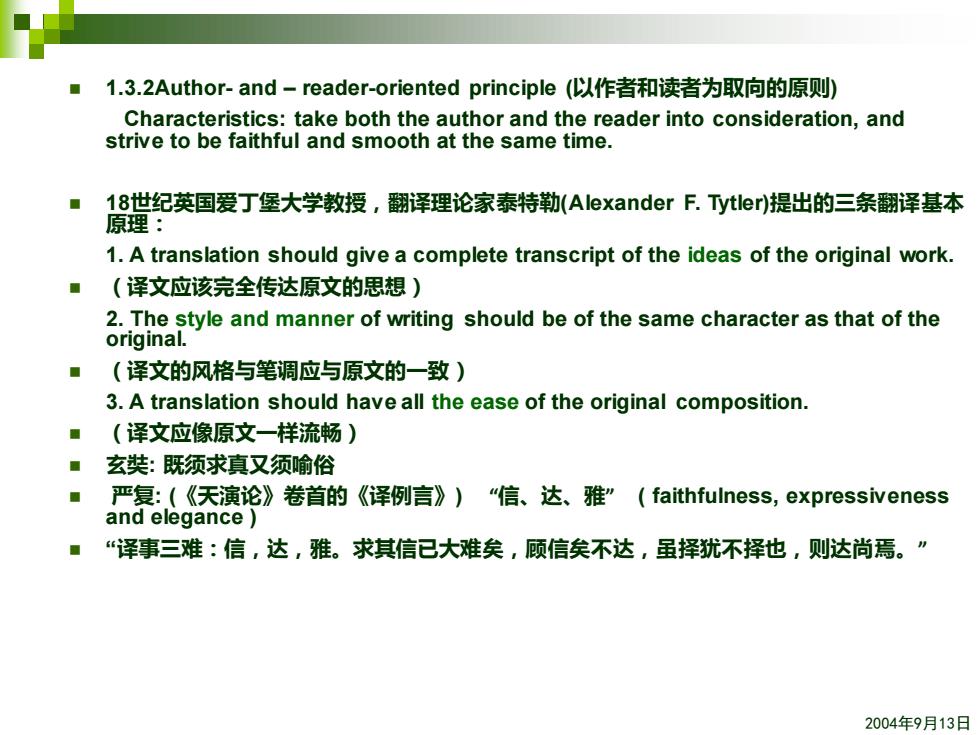
舍句翡蚕一警鑫墨:於上 从意义上讲,句子能够表示一个完整意思 昌手拳著÷烏譬努 这些都是句子在层级上高于词和词组之处。汉语的句子 在 理解时容身识别,较容易分析,在表达时又较容易重构 转换成与之对应的英语句子。 必须注意的是,一个句子与相邻的包子之间存在,一定语义 的关联,这种吴联总在以显性或隐性的方式连接在二起.正 确地理解一个句子往往不夜要看它本身,往往还要依赖于 与它相邻的句子甚至整个篇章,所以孤立地翻译句子希忽 视句际之间的关系是不可取的: 2004年9月13日
2004年9月13日 ◼ 从意义上讲,句子能够表示一个完整意思;从功能上讲, 句子表示陈述,疑问,祈使,感叹等语气;从形态上讲, 句子末端有句号,问号或感叹号为标志。 ◼ 这些都是句子在层级上高于词和词组之处。汉语的句子, 在理解时容易识别,较容易分析,在表达时又较容易重构, 转换成与之对应的英语句子。 ◼ 必须注意的是,一个句子与相邻的句子之间存在一定语义 的关联,这种关联总在以显性或隐性的方式连接在一起.正 确地理解一个句子往往不仅要看它本身,往往还要依赖于 与它相邻的句子甚至整个篇章,所以孤立地翻译句子而忽 视句际之间的关系是不可取的

1.3汉英翻译的标准(criteria) Criteria of translation is the plumb-line for measuring the quality of a translation and the goal for a translator to strive for. ■ 1.3.1 Source-language-oriented principle(以译出语为取向的原则), Characteristics:pay extreme attention to the form of the source text,always adopts a word-for-word/line-for-line translation or transliteration. e.g.他是只纸老虎 He is a paper tiger. 这事让他丢脸 This makes him lose face. 2004年9月13日
2004年9月13日 1.3 汉英翻译的标准(criteria) ◼ Criteria of translation is the plumb-line for measuring the quality of a translation and the goal for a translator to strive for. ◼ 1.3.1 Source-language–oriented principle(以译出语为取向的原则). Characteristics: pay extreme attention to the form of the source text, always adopts a word-for-word / line-for-line translation or transliteration. e.g. 他是只纸老虎 He is a paper tiger. 这事让他丢脸 This makes him lose face

it rains cats and dogs(?) the Milky Way (? the apple of one's eye(?) ■)Target-language-oriented principle(以译入语为取向的原则) Liberal/free translation: e.g.:What is done is done. 木已成舟 Kicking a man when he is down. 打落水狗/落井下石 Liberal translation:using large number of domestication/ adaptation for the reader's sake.This is done at the cost of the loss or damage of the original image sometimes. 三个臭皮匠,合成一个诸葛亮 Two heads are better than one. 2004年9月13日
2004年9月13日 ◼ it rains cats and dogs (?) the Milky Way (?) the apple of one’s eye (?) ◼ 2) Target-language-oriented principle (以译入语为取向的原则) Liberal / free translation: e.g.: What is done is done. 木已成舟 Kicking a man when he is down. 打落水狗/落井下石 Liberal translation: using large number of domestication / adaptation for the reader’s sake. This is done at the cost of the loss or damage of the original image sometimes. 三个臭皮匠,合成一个诸葛亮 Two heads are better than one

1.3.2 Author-.and-reader-oriented principle(以作者和读者为取向的原则) Characteristics:take both the author and the reader into consideration,and strive to be faithful and smooth at the same time. ■ 18世纪英国爱丁堡大学教授,翻译理论家泰特勒(Alexander F.Tytler)提出的三条翻译基本 原理: 1.A translation should give a complete transcript of the ideas of the original work. ,(译文应该完全传达原文的思想) 2.The style and manner of writing should be of the same character as that of the original. (译文的风格与笔调应与原文的一致) 3.A translation should have all the ease of the original composition. (译文应像原文一样流畅) ■ 玄奘:既须求真又须喻俗 严复:(《天演论》卷首的《译例言》)“信、达、雅”(faithfulness,expressiveness and elegance “译事三难:信,达,雅。求其信已大难矣,顾信矣不达,虽择犹不择也,则达尚焉。” 2004年9月13日
2004年9月13日 ◼ 1.3.2Author- and – reader-oriented principle (以作者和读者为取向的原则) Characteristics: take both the author and the reader into consideration, and strive to be faithful and smooth at the same time. ◼ 18世纪英国爱丁堡大学教授,翻译理论家泰特勒(Alexander F. Tytler)提出的三条翻译基本 原理: 1. A translation should give a complete transcript of the ideas of the original work. ◼ (译文应该完全传达原文的思想) 2. The style and manner of writing should be of the same character as that of the original. ◼ (译文的风格与笔调应与原文的一致) 3. A translation should have all the ease of the original composition. ◼ (译文应像原文一样流畅) ◼ 玄奘: 既须求真又须喻俗 ◼ 严复: (《天演论》卷首的《译例言》) “信、达、雅” ( faithfulness, expressiveness and elegance ) ◼ “译事三难:信,达,雅。求其信已大难矣,顾信矣不达,虽择犹不择也,则达尚焉

● Yan Fu's "faithfulness"means the full and complete conveying or transmission of the original content or thought. His "expressiveness"demands that the version must be clear and flowing without any grammatical mistakes or confused logic and sense. So the first two words as translation criteria are acceptable.But his "elegance" is unadoptable because it refers to the use of classical Chinese before that Han Dynasty.Yan Fu held that only the language before the Han Dynasty could be considered elegant and old vocabulary,old structure of Chinese must be used in order to represent the original fully and adequately. Therefore he can be said to object to the use of the vernacular or popular language of the people.As a matter of fact,the vernacular began to be in fashion when Yan Fu lived.Facts prove the vernacular or the popular language of the people can be used to translate any foreign language in the world. ■ So many people criticized his“elegance.”Furthermore,His“elegance”can only be regarded as one style.Its opposite is the style of "boldness"."Elegance"and "boldness constitute two different styles.Of course there are many other styles in translation. 鲁迅(《题未定草》“凡是翻译,必须兼顾两面,一当然力求其易解,一则保存着原作 的丰姿.";“信,顺”(faithfulness,smoothness) 2004年9月13日
2004年9月13日 ◼ Yan Fu’s “faithfulness” means the full and complete conveying or transmission of the original content or thought. ◼ His “expressiveness” demands that the version must be clear and flowing without any grammatical mistakes or confused logic and sense. ◼ So the first two words as translation criteria are acceptable. But his “elegance” is unadoptable because it refers to the use of classical Chinese before that Han Dynasty. Yan Fu held that only the language before the Han Dynasty could be considered elegant and old vocabulary, old structure of Chinese must be used in order to represent the original fully and adequately. ◼ Therefore he can be said to object to the use of the vernacular or popular language of the people. As a matter of fact, the vernacular began to be in fashion when Yan Fu lived. Facts prove the vernacular or the popular language of the people can be used to translate any foreign language in the world. ◼ So many people criticized his “elegance.” Furthermore, His “elegance” can only be regarded as one style. Its opposite is the style of “boldness”. “Elegance” and “boldness ” constitute two different styles. Of course there are many other styles in translation. ◼ 鲁迅 (《题未定草》)“凡是翻译,必须兼顾两面,一当然力求其易解,一则保存着原作 的丰姿.”;“信,顺”(faithfulness,smoothness)